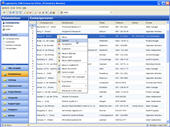
Here’s the circuit diagram.Ladder diagrams are specialized schematics commonly used to document industrial control logic systems. After that, we can use the IC to get the output on Pin 8, 9, 11 and 12. After that connect the second clock pin (Pin 2) with the output of timer or any other pulse generate to change the output. In other cases when we need to control the reset then pins configuration for reset pins will be different. After that connect the reset pins with the ground.

First, connect the powers and then connect the first clock pin (Pin 1) with the last bit (Pin 12). The pins we are going to use for the 74LS93 binary counter are two input pins, two reset pins, and four output pins.

Note: Further details on electrical features and specifications are available in the datasheet.ħ4LS93 DataSheet How does 74LS93 Digital Counter Works?
#MIPS LOGICWORKS MOD#
It uses to give the pulse to the mod two counter in the IC. Pin 14 is the second input pin of the IC. It gives the last bit of the 4-bit binary data. It gives the first bit of the 4-bit binary data. It is used to make the IC ground common with the other compatible devices to make it functional with them. It gives the second bit of the 4-bit binary data. The actual output comes in 4 pins and Pin 8 gives the third bit of 4-bit binary data. Pin 6 and Pin 7 are also the NC pins of the IC. Pin 5 is a power pin used to power up the IC to make it functional.

It can be used to the PCB for proper support of IC with the board. Pin 4 is known as NC (no connection) pin which doesn’t have any role in the internal circuit of the IC. Pin 3 is the second reset pin used to reset the counter. Pin 2 is a reset pin used to reset the counter in case of any requirement. The IC consist of multiple mod counters, The Pin 1 is used to give the pulse to mod eight counter. The 74L93 binary counter comes up with internal protection from high-speed termination. It comes in multiple packages such as DIP, SMD with all 14-pins. This is compatible with any microcontroller or TTL based devices. The whole IC gives the output 4 bits which counts from 0 to 15 in binary. The IC is made up of two counters one is mod 2 counter another one is mod 8 counter. The 74LS93 IC comes up with two reset pins, two clock pins, and four output pins. We can use the microcontroller or timer IC for pulse input. It consists of 4 JK flip flops which act on the input pulse no matter how we gave the input pulse. Here we will discuss 74LS93 which is a four-bit counter. Both these types of counters use the flip flops to count the binary digits. Counters come up in two form Asynchronous and Synchronous counters. The output of the counters can be used in multiple devices as pulse counting or for generating interrupts, etc. Counters have a major role in every electronics device. 74LS93 or SN74LS93 is a 4-bit binary counter.


 0 kommentar(er)
0 kommentar(er)
